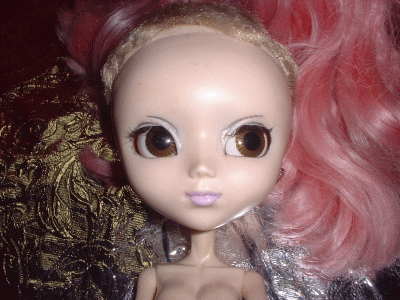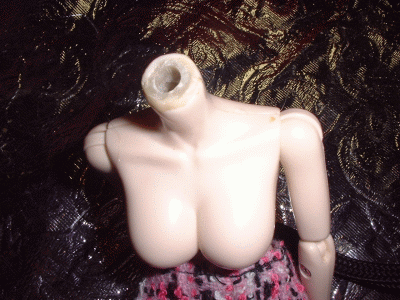
Fantabulous Neck Fixin' Tutorial!
Pullip neck replacement made easy... ish
A neck-replacement tutorial for Pullips.
While this is intended for the old-bodied Pullips, new-bodied Pullips' necks
CAN AND WILL break, if you tug on them too roughly.
I haven't used this on a new body yet, however, I would caution one to be very
careful of the soft plastic.
The first few Pullips are adorable, aren't they? We all want Moon. BECAUSE MOON IS LIFE.
I was lucky enough to be one of those people who found out about Pullips early,
and got Moon when she was retail price -- yay, dumb luck! As a result, I had
no dire warnings to be gentle with her, and SNAP! Off with her head.
I tried various fixes first, trying to re-create her neck joint. She kept snapping.
Finally, Team Cute figured out a way to permanently fix her head -- she's gone
through many months of rough play and she's still super sturdy. (Edit: Until
the latest, greatest break-and-fix. We'll tell you about that later.)
If you have an old Pullip, it's almost certain to happen to you eventually.
Some people replace the bodies. Some people sell theirs when it happens. Some
people pay others to fix it for them. (Madison of Magma Heritage has, in the
past, claimed he would pay to ship any doll he sold to Jun Planning for replacement/fix.)
But if you want to do it yourself, here's what we did:
Materials
Optional:
Basically, you cement adowel inside of her neck. I used a dowel almost as wide as her neck, and just widened her neck-hole to fit it -- but if you don't want to carve up her hole, make sure you use a dowel the same size as the hole. (Or a little smaller, and reinforce it with epoxy) Obviously, the bigger dowel will be sturdier.
So, first of all: scrape any bits out of your neck. Remove the tiny screw from the top of the neck.

Check your dowel to make sure it 1. fits inside of the neckhole and 2. fits on the head-hole. Again, a smaller (to fit the head-hole) dowel will be less sturdy, and need to be cemented with more epoxy. A larger (to fit snugly in the neckhole) dowel will be slightly more sturdy, but the head's hole will need to be carved open a bit.
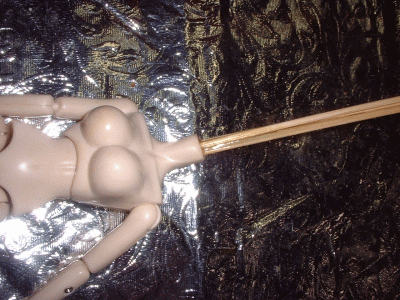
This is actually a compound dowel, made up of smaller dowels epoxied together.
No real advantage, it's just all I had on hand.
Cut your dowel. You only need a 1/2" or so showing above the neck. Make sure you push it all the way down -- as stated later, I generally remove the top tiny screw, and use the entire neck cavity. We're not emulating the existing Pullip neck knob, we're making a sturdier one.
You want to make a glob of apoxie right above where the base of the head sits, to act as a "stopper" so the head won't come off... just like the newer Pullips' neck joints. So, pull the head back off, make the stopper blob, and wait for it to dry. This part is tricky -- you only want the barest section of exposed dowel before the "stopper." What I've done on later fixes is to fit the dowel in the neck, put epoxy AROUND the top (but not touching the neck), let dry, then cement the dowel so that a small base of wood shows through, for our "stopper." I'll try to get better pics/explanation of this next time.
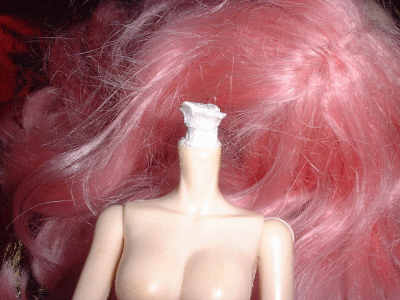
Once you're satisfied with the top epoxy, you're going to want to cement the neck-stopper into the neck, using yet more epoxy. Generally, I use the entire neck-cavity for added stability, and discard the tiny screw at the top of the neck.
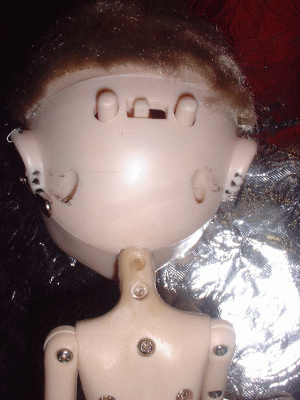
Screw-hole at top of neck extruding clear epoxy.
Once the epoxy is dry, COMPLETELY DRY, you will want to try it on the head. Take your screwdriver and unscrew the two side screws on the lower back of the head. DO NOT COMPLETELY OPEN THE HEAD. Pullip heads are horrible, horrible nightmares to re-assemble. (For the Blythe people: so much worse.)
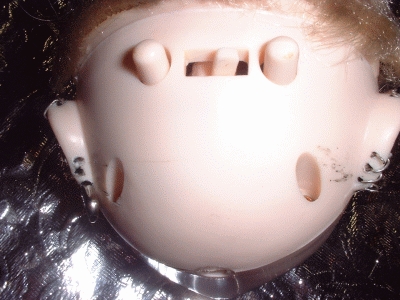
These two screws.
Put the screws somewhere safe. Really safe. Like taped to a piece of cardboard,
or in a ziplock bag.
Next, you're going to want to wedge the head open -- this can be a two-person
job. I like to use a flat-head screwdriver to hold her open -- you can wrap
the screwdriver tip in masking tape for safety.
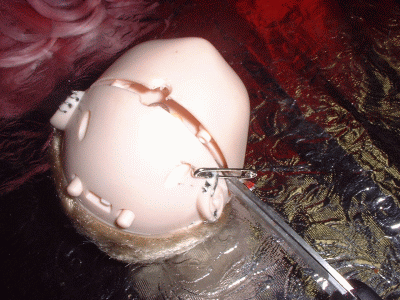
Stick your (COMPLETELY DRY) epoxy-dowel-ma-bob in there, and remove the wedge.
The head should close completely flush. If it gaps, you need to take the dowel-stopper
out, and either carve down the stopper (right at the base of the stopper, right
before it connects to the Pullip neck) or widen the head-hole to fit it. Adjust
until the head closes tightly, then put your screws back in, and tighten them
down. Ta-da! A whole and healthy Pullip.
